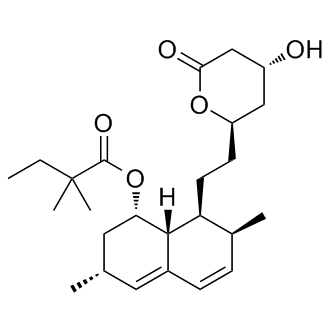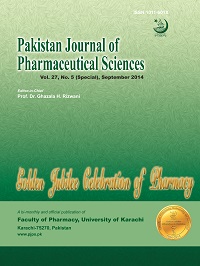All AbMole products are for research use only, cannot be used for human consumption.

Simvastatin (MK-0733, MK 733) is a competitive inhibitor of HMG-CoA reductase with Ki of 0.1-0.2 nM in cell-free assays. Simvastatin induces ferroptosis, mitophagy, autophagy and apoptosis. Simvastatin inhibits exosome release.
Prior to use in cell assays, Simvastatin needs to be activated by NaOH in EtOH treatment. Simvastatin inhibits cholesterol synthesis in mouse L-M cell (fibroblast), rat H4II E cell (liver), and human Hep G2 cell (liver) with IC50 of 19.3 nM, 13.3 nM and 15.6 nM, respectively. Simvastatin treatment leads to a dose-dependent increase in serine 473 phosphorylation of Akt within 30 minutes, with maximal phosphorylation occurring at 1.0 µM.
In vivo, Simvastatin orally administration inhibits the conversion of radiolabeled acetate to cholesterol with IC50 of 0.2 mg/kg. Simvastatin (4 mg/day) orally administration for 13 weeks to rabbits fed an atherogenci cholesterol-rich diet, returns the cholesterol-induced increases in total cholesterol, LDL-cholesterol and HDL-cholesterol to normal level. Simvastatin (6 mg/kg) produces an increase in LDL receptor-dependent binding and increases the number of hepatic LDL receptors in rabbits fed a diet containing 0.25% cholesterol.
Activation of simvastatin
Simvastatin needs to be activated by opening of the lactone ring before use in cell culture. Briefly, eight milligrams of simvastatin (0.019 mM) were dissolved in 0.2 ml of 100% ethanol, with subsequent addition of 0.3 ml of 0.1 N NaOH. The solution was heated at 50°C for 2 h in a sand bath and then neutralized with HCl to pH 7.2. The resulting solution was brought to a final volume (1 ml) with distilled water, and aliquots were stored at −80°C until use.

J Funct Foods. 2022 Mar;Volume 90, 104998.
Epigallocatechin-3-gallate + L-theanine/β-cyclodextrin inclusion complexes enhance epigallocatechin-3-gallate bioavailability and its lipid-lowering and weight loss effects
Simvastatin (MK 733) purchased from AbMole

Molecules. 2022 Jul 31;27(15):4894.
Metagenomics Approach to the Intestinal Microbiome Structure and Abundance in High-Fat-Diet-Induced Hyperlipidemic Rat Fed with (−)-Epigallocatechin-3-Gallate
Simvastatin (MK 733) purchased from AbMole

Chem Res. 2021 Oct 18.
Comprehensive Analysis of Differential Gene Expression Profile via RNA Sequencing in the Human Ovarian Cancer SKOV3 Cells Treated with Simvastatin
Simvastatin (MK 733) purchased from AbMole

Pak J Pharm Sci. 2016 May;29(3 Suppl):1043-51.
Chromatographic resolution of drug analogues: 3-hydroxy-3-methylglutarylcoenzyme A reductase inhibitors (statins)
Simvastatin (MK 733) purchased from AbMole
| Molecular Weight | 418.57 |
| Formula | C25H38O5 |
| CAS Number | 79902-63-9 |
| Solubility (25°C) | DMSO 80 mg/mL |
| Storage |
Powder -20°C 3 years ; 4°C 2 years In solvent -80°C 6 months ; -20°C 1 month |
[2] Tanzeela A Fattah, et al. Synthetic Approaches Towards Antihypercholesterolemic Drug Simvastatin
| Related Autophagy Products |
|---|
| NEO214
NEO214 is an autophagy inhibitor and a covalent conjugate of the PDE4 inhibitor Rolipram and perillyl alcohol. NEO214 has anti-cancer activity and blood-brain barrier (BBB) permeability. NEO214 prevents autophagy-lysosome fusion, thereby blocking autophagic flux and triggering glioma cell death. |
| Ammonium chloride-15N
Ammonium chloride-15N is the 15N labeled Ammonium chloride. Ammonium chloride is an autophagy inhibitor. Ammonium chloride is also a lysosome inhibitor. |
| Vacuolin-1
Vacuolin-1 is a cell-permeable inhibitor of Ca2+ dependent fusion of lysosomes to the cell membrane. Vacuolin-1 blocks the Ca2+-dependent exocytosis of lysosomes and prevents the release of lysosomal content without affecting the process of resealing. vacuolin‐1 is a potent and selective PIKfyve inhibitor and inhibits late‐stage autophagy by impairing lysosomal maturation. |
| CA77.1
CA77.1 is a potent, brain-penetrant and orally active chaperone-mediated autophagy (CMA) activator with favorable pharmacokinetics. |
| KAN0438757
KAN0438757 is a potent and selective inhibitor of the metabolic kinase PFKFB3 with an IC50 of 0.19 μM. |
All AbMole products are for research use only, cannot be used for human consumption or veterinary use. We do not provide products or services to individuals. Please comply with the intended use and do not use AbMole products for any other purpose.


Products are for research use only. Not for human use. We do not sell to patients.
© Copyright 2010-2024 AbMole BioScience. All Rights Reserved.
